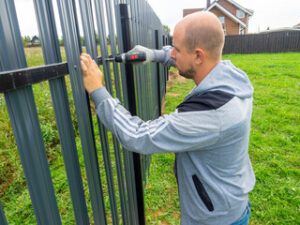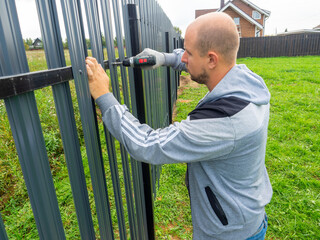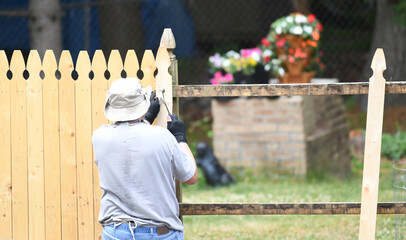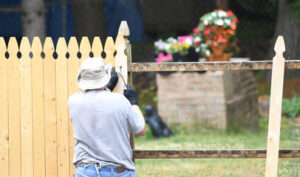Fences are subject to a variety of outside forces that can cause them damage. Whether it’s from storms, physical damage, or neighbors’ dogs, these damages can be costly.
Often, homeowners wonder what to expect when it comes to repairing their fences. We’ve put together this guide to help you understand what the cost of fence repair and installation entails. To save time and money, call Fence Repair Round Rock experts.
 Fences are an important part of any property, providing privacy, security, and aesthetic appeal. However, like any other structure, fences can become damaged over time due to weather, wear and tear, or accidents. When a fence is damaged, it not only affects its functionality but can also detract from the overall appearance of your property. In this article, we will explore the importance of fence repair and the common types of fence damage that require repair.
Fences are an important part of any property, providing privacy, security, and aesthetic appeal. However, like any other structure, fences can become damaged over time due to weather, wear and tear, or accidents. When a fence is damaged, it not only affects its functionality but can also detract from the overall appearance of your property. In this article, we will explore the importance of fence repair and the common types of fence damage that require repair.
Repairing Damaged Posts
If the fence posts in your yard are beginning to show signs of wear and tear, you’ll need to decide whether a quick fix or full replacement is the best route. In most cases, you’ll find that repairing a damaged post is a more cost-effective option than replacing it entirely.
Wood fences often suffer from damage caused by moisture, resulting in splits and cracks in the posts and panels. A common remedy is to use wood putty to fill the cracks, but it’s also important to treat the repaired areas with a water-resistant stain or paint to protect them from moisture.
In some cases, a broken or leaning post can be stabilized by using an expanding foam product. This product works well to support the post and can be purchased at most home improvement stores.
A more permanent solution to a broken or leaning fence post is to replace it with a steel replacement. Steel is sturdier than wood and has the added benefit of being corrosion-resistant.
Replacing a damaged post is more labor-intensive than simply repairing an existing one, but it’s an effective long-term solution for your fence. Before starting, make sure to dig around the base of your fence post and remove any grass or dirt that has accumulated there. Once the old post has been removed, dig a hole that’s at least as deep as the current one and prepare to set your new replacement.
When the horizontal rails that hold your fence screen–whether it’s pickets or solid boards–begin to sag, you can usually resolve this issue by adding a brace between the top and bottom rails. This will help to re-stabilize the entire fence screen. Another option is to install a metal post-rail connector. This will tighten and strengthen the fasteners that secure the existing rails to the posts, making them more rigid and less prone to sagging.
If the existing rails are simply weathering and losing their luster, brush a bit of wood preservative on the end grain to arrest incipient rot and then reattach them with galvanized nails or screws. You can also set a piece of lumber or scrap wood in the ground in front of the post to prevent it from tilting during storms.
Repairing Sagging Gates
Over time, it’s not uncommon for your fence gate to sag. This can cause problems with opening and closing your gate as well as making it look unsightly. Fortunately, fixing this problem isn’t difficult and can be done yourself with just a few tools.
First, examine your gate to see if it’s just the swinging portion that is sagging or if the post it’s attached to is also leaning. If the post is damaged beyond repair, you’ll need to replace it with a new one. Then, examine the gate hinges to make sure they are tight and aligned correctly with each other. If they are loose or the bolts are rusted, it may be time to replace them.
If the gate is just sagging, you can use a piece of two-by-four wood to slide under the outer edge of the gate and raise it. This will help remove the sag and allow it to swing properly. Then, add a second brace on the inside corner of the gate to provide additional support. If your gate is larger than 5 feet wide or 3 feet high, you should also consider adding a third hinge for extra strength.
Once you’ve made the necessary adjustments to your gate, examine the condition of the gate post. If it’s showing signs of deterioration, you should replace it with a new gate post-treated with a preservative. To do so, dig a hole that’s 12 inches deeper than the existing post hole and about 2 1/2 to 3 times as wide.
Once the post is in place, you can use a level to ensure it’s completely horizontal and plumb. Then, you can pour a two-part foam–Sika PostFix is one example–around the base of the post to stabilize it and allow it to cure according to the manufacturer’s instructions. Once the post is straight, you can reattach your gate and finish any touch-ups to the hinges and latch. Once your gate is reattached and the hinges are set, it’s a good idea to test it by pulling on it and jiggling it to ensure that it swings evenly and can close properly.
Repairing Rust
Wrought iron fences add flair and boost the security of homes, but they are susceptible to rust that not only detracts from their look but can cause structural damage. Left untreated, rust can lead to broken or chipped paint and structural problems such as bending and cracking. Fortunately, repairing rust on fences is relatively straightforward and can be done in a matter of days.
The first step is identifying and removing any rust spots on the surface of the metal. This can be done with steel wool, a wire brush, or sandpaper. It is important to get rid of as much rust as possible because any rust that remains will continue to spread and could eat through the metal, eventually weakening or damaging it.
After all of the rust has been removed and the metal is dry, it can be painted. Special rust-resistant primer and paint should be used to help protect the metal from future rusting. When painting, it is a good idea to use a paint sprayer to ensure even coverage. It is also a good idea to wear a mask and goggles when working on metal to prevent inhaling any rust particles.
Once the paint is on, it is important to visually inspect the fence a few times throughout the year to make sure that no new rust spots are forming. These small checks are important because they will keep you from needing to perform a large-scale de-rusting of the entire fence in the future. It is also a good idea to keep a can of the same paint that was used on hand to do spot treatments.
The old saying “an ounce of prevention is worth a pound of cure” certainly applies to wrought iron fences. By following these simple tips, you can extend the life of your wrought iron fence and reduce the chances of needing extensive repairs in the future. Keeping up with regular inspections, cleaning rust spots as soon as they appear, and using the recommended rust-fighting materials, you can keep your wrought iron fence looking great for years to come!
One of the most common types of fence damage is broken or damaged posts. Fence posts are the backbone of any fence, providing support and stability. When a post is damaged or broken, it can compromise the entire fence’s structural integrity. This type of damage is often caused by severe weather conditions such as strong winds, heavy rain, or snow. It can also be caused by accidental impact from vehicles or falling objects. In such cases, fence repair may involve replacing the damaged post or reinforcing it with additional support.
Another common type of fence damage is broken or damaged boards or panels. This type of damage is often caused by wear and tear, age, or exposure to the elements. It can also be caused by accidental impact or vandalism. Broken or damaged boards or panels can compromise the fence’s appearance and functionality, as well as its ability to provide privacy and security. Fence repair in such cases may involve replacing the damaged boards or panels or reinforcing them with additional support.
In addition to broken posts and panels, fence repair may also involve fixing damaged gates or hinges. Gates are an important part of any fence, providing access and security. When a gate is damaged or broken, it can compromise the fence’s functionality and security. This type of damage can be caused by wear and tear, age, or exposure to the elements. It can also be caused by accidental impact or vandalism. Fence repair in such cases may involve replacing the damaged gate or hinges or reinforcing them with additional support.
Regardless of the type of fence damage, it is important to address it promptly to prevent further damage and ensure the fence’s longevity. Delaying fence repair can lead to more extensive damage and costly repairs down the line. It can also compromise the fence’s ability to provide privacy, security, and aesthetic appeal.
When it comes to fence repair, it is important to choose a reputable and experienced fence contractor. A professional contractor will have the necessary knowledge and expertise to assess the damage, recommend the appropriate repair options, and perform the repairs efficiently and effectively. They can also provide guidance and recommendations based on your specific needs and budget.
In conclusion, fence repair is an important part of maintaining your property’s privacy, security, and aesthetic appeal. Whether it’s broken posts, damaged boards or panels, or damaged gates or hinges, addressing fence damage promptly can prevent further damage and ensure the fence’s longevity. Choosing a reputable and experienced fence contractor is key to ensuring the repair is done efficiently and effectively. With proper maintenance and repair, your fence can continue to provide the necessary functionality and appeal for years to come.



